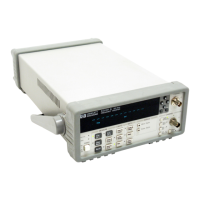Chapter 2 Operating Your Frequency Counter
Using CHANNEL 1 Input Conditioning Keys
2-42 Operating Guide
2
While AUTO TRIG: is ON, the Counter will, for each measurement, check that the
measurement signal is triggering at the current level. If no triggering is found, the
Counter will measure and compute a new trigger level. (While AUTO TRIG: is ON,
the Counter also measures and computes a new trigger level whenever measuring is
invoked with the front-panel Stop/Single and Run keys, or whenever the auto-trigger
percentage is updated.)
The menu items under the Trigger/Sensitivity key also allows you to manually:
• select what slope or edge (positive or negative) of an input signal will trigger the
Counter (SLOPE: POS or NEG).
• select medium, high, or low sensitivity levels (thus, varying the hysteresis
window or trigger band) for the optimum sensitivity for certain measurement
applications (SENSTVTY: MED, HI, or LOW).
DEFINITION OF SENSITIVITY. Sensitivity is the lowest amplitude signal at a
particular frequency that the Counter will count. The amplifier gain and the voltage
difference between the input trigger hysteresis levels determine the Counter’s
sensitivity. Sensitivity is specified with the trigger level set at a value equal to the
midpoint of the input signal. The input waveform must cross both the upper and lower
hysteresis levels to generate a count as shown in the following figure.
Signal crosses through both hysteresis levels to effect a count.
Upper
Hysteresis
Level
Peak-to-Peak
Sensitivity
Trigger
Level
Lower
Hysteresis
Level
Input signal
to Counter

